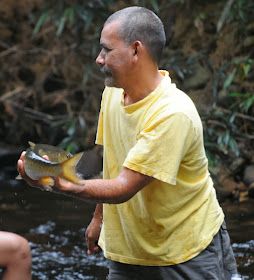Taman Negara is a big place, and during most of my time as a lecturer for the MNS Intermediate Birding Course (in September 2012) I was confined to its western edge, at Merapoh. I only had one chance to penetrate the park further than I could reach in a short stroll along the entrance road: a drive to the foot of Gunung Tahan, Taman Negara's highest point. Actually, Gunung Tahan was not our destination; that was Sungai Relau, a base for climbers and, among things, a fish sanctuary.
"Sungai" means river or stream. The Sungai Relau Sanctuary sits, as you might expect, on the banks of the Relau River, amid stands of Neram trees (Dipterocarpus oblongifolius).
Limestone boulders in the river bed were popular with damselflies, including the species I featured in the post before last.
The river is popular with visitors, who flock to its banks to see the fishes.
The sanctuary protects a valuable game fish that has, elsewhere, been exploited to the point of near-disappearance. This is the Malaysian Mahseer (Tor tamroides), also known as Kelah or Empurau. It is extremely (one might say ridiculously) expensive as a main course, but here it is protected. You can feed them, but you can't catch them.
I suspect that all these fishes are Mahseer, too, but some may be the related Sultan fish (Leptobarbus hoevenii).
Now, when I say you can't catch the fishes here, I should qualify that a bit.
This gentleman seems quite able to catch them bare-handed. After showing them off, mind you, he puts them back.
Limestone boulders in the river bed were popular with damselflies, including the species I featured in the post before last.
The river is popular with visitors, who flock to its banks to see the fishes.
The sanctuary protects a valuable game fish that has, elsewhere, been exploited to the point of near-disappearance. This is the Malaysian Mahseer (Tor tamroides), also known as Kelah or Empurau. It is extremely (one might say ridiculously) expensive as a main course, but here it is protected. You can feed them, but you can't catch them.
I suspect that all these fishes are Mahseer, too, but some may be the related Sultan fish (Leptobarbus hoevenii).
Now, when I say you can't catch the fishes here, I should qualify that a bit.
This gentleman seems quite able to catch them bare-handed. After showing them off, mind you, he puts them back.
While hunting for damselflies along the river, I had a chance to notice other things, including this cricket skulking beneath a bit of driftwood.
This, I presume, is the work of a colony of termites.
This handsome insect appears to be a shield bug of some sort.
Fungi of various sorts sprouted from rotting wood on the forest floor near the river bank.
Poking around in the undergrowth looking for interesting things can be a bit risky, especially if you are anywhere near some of the excruciatingly spiny trunks of raffia palms.
As always, I find myself intrigued by more plants than I am capable of identifying. I have no idea what the bearer of this fruit actually is.
Nor can I name the bearer of these attractive leaves, though I suspect that it is a dipterocarp of some sort.
Here, though, is a plant I have been able to identify: a Philippine Orchid (Spathoglottis plicata). It is not only widespread in its native range in Southeast Asia, but it has become an invasive species in many other parts of the world including Florida and West Indies.
I was only able to photograph one bird at Sungai Relau, but it put on quite a performance. The Grey-headed Canary-Flycatcher (Culicicapa ceylonensis) is neither a canary nor a flycatcher, but a member of a small group of African and Asian forest birds only recently recognized as both related to each other. They have now been placed in their own family, the Stenostiridae.
On the way back to Merapoh, our group had a chance to stop at a lookout tower, the jumping-off point for those brave, or fit, enough to follow the trail to the summit of Gunung Tahan.
From here, we could admire the scenery...
... look down at our vehicles on the road below...
... or simply take in the sounds of the forest around us. The most memorable of these were the calls of a pair of Helmeted Hornbills (Rhinoplax, or Buceros, vigil): a remarkable series of yelps followed by cackling, maniacal laughter. In Malaysia, I was informed, the Helmeted Hornbill is known as the "kill your mother-in-law bird (Tebang mentua)" because its call sounds like a disgruntled husband doing in his relation with an axe and reveling in the accomplishment afterwards. Of course there is a story to go with the name. Whatever the call means, either to people or to the birds that make it, it has remained one of my strongest memories of my visit to Taman Negara.






DSC_4059_resize.JPG)
DSC_4050_resize.JPG)
DSC_4051_resize.JPG)
DSC_4058_resize.JPG)

























No comments:
Post a Comment